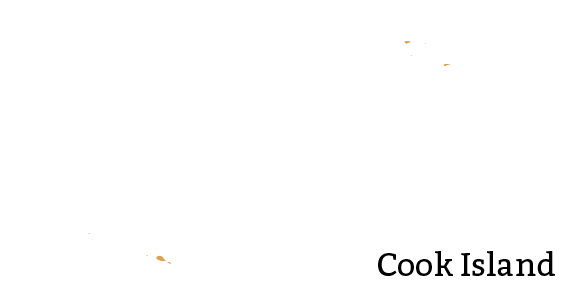
The Cook Islands are a nation of 15 islands spread out across a vast area of 2 million square kilometers in the South Pacific. Rarotonga is the largest island and home to the capital. Aitutaki Island, which is the Cook Islands’ second most visited locale after Rarotonga, is 220 kilometers (or a 50-min flight) from Rarotonga and is a popular tourist destination for honeymooners because of its vast lagoon encircled by coral reefs and small, sandy islets. Politically, the nation is essentially independent and self-governing but has a free-association with New Zealand, a country the Cook Islands rely on heavily for defense and financial aid. With a total population of approximately 8,327 people, the Cook Islanders have a blend of ancient Polynesian Maori heritage with Western influences. The agriculture sector employs more than a quarter of the working population and provides their economic base through agricultural exports, while sectors such as tourism, fisheries, and seabed mining have attracted investment and promising future economic growth.
According to Mark Brown, the Deputy Prime Minister of the Cook Islands, the future prosperity of the nation will depend on technology and how they use it. However, due to the country’s isolation, composition of scattered islands, and periodic devastation from natural disasters, achieving adequate infrastructure development has been a challenge.
Since 1989, all fixed and mobile broadband access in the Cook Islands has been provided by a single telecommunications operator, Telecom Cook Islands Limited (TCI), a 60:40 joint venture between TCNZ Cook Islands Limited (TCNZ) and the Cook Islands Government. TCI contracted with satellite operator O3b Networks for internet service through medium earth orbit (MEO) satellite transponders. The service was launched in Rarotonga in late 2013 and, combined with Very Small Aperture Terminal (VSAT) terminals, provided to some commercial users under arrangements with TCI. Satellite networks provided the sole means for international connectivity to the Cook Islands until January 2020, when the first undersea cable arrived on the shore of Rarotonga to improve bandwidth and complement the existing satellite service. The 3600km long fibre optic submarine cable, named Manatua One Polynesia Cable, spans the South Pacific and connects Rarotonga and Aitutaki with Niue, Samoa, Tahiti, and Bora Bora in French Polynesia. The project was completed as a result of the international collaboration between the four nations and the culmination of three years of planning, design, and implementation.
The Rarotonga-Aitutaki portion of the Manatua cable was constructed by Avaroa Cable Ltd (ACL), a state-owned enterprise (SOE) that oversees cable operations and sells the cable’s bandwidth to internet service providers in the Cook Islands. However, Vodafone Cook Islands is currently the sole service provider and signed a multi-year partnership with ACL for use of the Manatua Cable. Vodafone is now working to replace the outdated copper wire network that currently connects the majority of homes and businesses in Rarotonga with an underground fibre network that can both withstand extreme weather events such as cyclones as well as handle the upsurge in bandwidth that the Manatua Cable delivers.
The Cook Islands’ involvement in the Manatua Cable Project was funded in part by a grant from the New Zealand Aid Programme and partially by a development loan from the Asian Development Bank. This paved the way for ACL, Vodafone, and the Cook Islands to be the first to make use of the Manatua One Polynesia cable. The development also coincided with ACL being the first company to be awarded a telecommunications operating license under the new Cook Islands Competition and Regulatory Authority Act 2019. Prior to this, the Cook Islands had been serviced exclusively by part government-owned TCI under a legislated monopoly with limited independent oversight.
Under the new policy, the government opened the telecommunications market to competition and hopes to achieve positive outcomes, such as a significant expansion in broadband access, as has been seen in several other Pacific Islands countries that have introduced competition. The competition policy was developed in collaboration with the Asian Development Bank-funded Pacific Private Sector Development Initiative with the specific objectives: to promote consumer welfare via access to new services and lower service prices; to create opportunities for investment; and to ensure high quality, sustainable, and reliable telecommunications infrastructure. In February 2020, Deputy Prime Minister, Mark Brown, announced the appointment of Bernard Hill as the inaugural chair of the Competition and Regulatory Authority to ensure a successful transition from the monopoly to a competitive telecommunications market.
As of September 2020, Vodafone had completed construction of an outer ring circling the coast of Rarotonga and connected approximately 20 businesses and government departments. However, according to Vodafone chief executive Phillip Henderson, the process of replacing all the old copper wire that currently connects the majority of homes and businesses is a time-consuming process and is expected to take years to complete. Also, because the market is dominated by Vodafone, more competition is required to fully realize the benefits of the Manatua cable, help prices come down, and for the quality of service to go up. In November 2020, four additional licenses were granted to local service providers, and Hill expects more licenses to be granted in the near future. Ranulf Scarbrough, the chief executive of ACL, echoed the value of competition and the necessity to minimize barriers to market entry.
In addition, Rarotonga and Aitutaki are the only islands in the Cook Islands that are currently connected to the Manatua cable. With no current plans or agreements announced to link any of the other 13 islands with optical fibre, it is clear that satellite systems like O3b will continue to play an important role for the foreseeable future to help bridge the digital divide for Cook Islanders in remote areas. Vodafone believes that those connected to the fibre network will likely achieve speeds up to 50 times faster than those who are not and will also potentially have more affordable service rates. A combination of strategies will be required to provide connectivity to all Cook Islanders.
